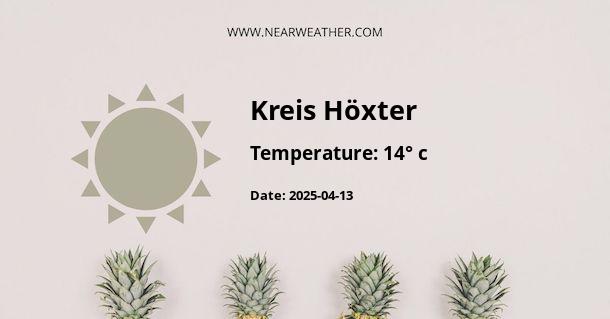Understanding the Climate and Weather in Kreis Höxter, Germany
Located in the eastern part of North Rhine-Westphalia, Kreis Höxter is a district that boasts a climate influenced by its geographical situation within Germany. Nestled near the Teutoburg Forest and the Egge Hills, its weather patterns exhibit characteristics of a temperate oceanic climate, with nuances brought about by its topography. In this detailed examination, we will explore the various aspects of Kreis Höxter’s climate, monthly weather patterns, and noteworthy weather phenomena, supported by statistics and expert analysis that could help us gain an in-depth understanding of this locality’s atmospheric conditions.
Annual Climate Overview
The climate in Kreis Höxter is generally mild, with moderate to heavy precipitation spread throughout the year. Summers are warm but not excessively hot, while winters are cold, yet not extremely harsh, making it suitable for various outdoor activities and agriculture. To provide a comprehensive overview, let’s delve into the climate specifics by seasons.
Seasonal Climate Patterns
"Kreis Höxter experiences a significant seasonal variation over the course of the year with a noticeable difference between summer and winter temperatures." - Climate Expert Analysis
Spring (March to May)
- Temperature: Average highs range from 8°C to 18°C, with lows from 0°C to 7°C.
- Precipitation: Moderate, with occasional increases in late spring due to thunderstorms.
- Weather Events: Late frosts can occur in early spring, affecting vegetation and agriculture.
Summer (June to August)
- Temperature: Average highs range from 20°C to 23°C, with nighttime lows around 11°C to 13°C.
- Precipitation: Despite being relatively high, summer often provides longer dry periods.
- Weather Events: Isolated thunderstorms are common, which can cause sudden, heavy downpours.
Autumn (September to November)
- Temperature: Average highs gradually decrease from 18°C to 8°C, while lows range from 9°C to 2°C.
- Precipitation: High, with increasing chances of persistent rain towards winter.
- Weather Events: Foggy conditions are more frequent and can lead to reduced visibility.
Winter (December to February)
- Temperature: Average highs of 2°C to 4°C and lows hovering around -3°C to -1°C.
- Precipitation: Snowfall is possible, particularly at higher altitudes in the region.
- Weather Events: Occasional icy spells can be disruptive and necessitate preparations.
Monthly Weather Statistics
The table below outlines average monthly weather statistics for Kreis Höxter, providing insight into temperature, precipitation, and notable weather events:
| Month | Average High (°C) | Average Low (°C) | Precipitation (mm) | Noteable Weather Events |
|---|---|---|---|---|
| January | 3 | -2 | 60 | Snowfall, Ice |
| February | 4 | -1 | 50 | Thaw, Fog |
| March | 8 | 0 | 60 | Late Frosts |
| April | 13 | 3 | 70 | Spring Showers |
| May | 18 | 7 | 90 | Thunderstorms |
| June | 21 | 11 | 100 | Summer Storms |
| July | 23 | 13 | 100 | Heat Waves |
| August | 23 | 12 | 90 | Humid Periods |
| September | 18 | 9 | 80 | Early Frosts |
| October | 13 | 6 | 70 | Autumnal Rains |
| November | 7 | 2 | 70 | Fog, Overcast Skies |
| December | 4 | -1 | 80 | Wintry Mix |
Climate Influencers
The climate in Kreis Höxter is subject to a range of environmental factors that create its unique weather landscape:
Geographical Position
The proximity of Kreis Höxter to larger bodies of water and its location within continental Europe both play a role in mitigating temperature extremes. Particularly, the North Sea to the northwest moderates winter cold and summer heat, producing an overall mild climate.
Topographical Effects
The varied terrain, with the uplands and lowlands, contributes to microclimates across the district. The higher elevations tend to experience cooler temperatures and more precipitation compared to the valleys, which can be slightly warmer and less prone to intense weather events.
Prevailing Wind Patterns
Westerly winds, common in this part of Europe, bring moist air from the Atlantic, resulting in regular precipitation. However, these winds also deliver temperate maritime influences, helping maintain the region’s moderate climate.
Effects of Climate on Life in Kreis Höxter
The climate has a significant impact on the daily lives and livelihoods of the people in Kreis Höxter. Agriculture, for instance, must be adapted to the seasons, with proper planning for spring frosts and autumn rains. Moreover, the distribution of precipitation throughout the year necessitates a sound understanding of water management for both urban and rural settings.
Climate Change Considerations
Recent climate trends indicate shifts in seasonal weather patterns, which could influence future climate scenarios in Kreis Höxter. Experts suggest that:
- Temperature averages may continue to rise, leading to hotter summers and milder winters.
- Precipitation extremes may become more frequent, with potential impacts on flooding and drought occurrences.
- Changes in vegetation periods and species distributions are possible as global warming progresses.
Clearly, understanding the local climate is essential for disaster preparedness, agriculture, infrastructure planning, and the overall well-being of the region’s inhabitants. As such, accurate and timely weather forecasting, along with long-term climate monitoring, remains a top priority for the authorities in Kreis Höxter.
A - Kreis Höxter's Latitude is 51.680561 & Longitude is 9.195830.
A - Weather in Kreis Höxter is 14° today.
A - Climate Conditions in Kreis Höxter shows overcast clouds today.
A - Humidity in Kreis Höxter is 79% today.
A - Wind speed in Kreis Höxter is 22.32 km/h, flowing at 225° wind direction. today.
